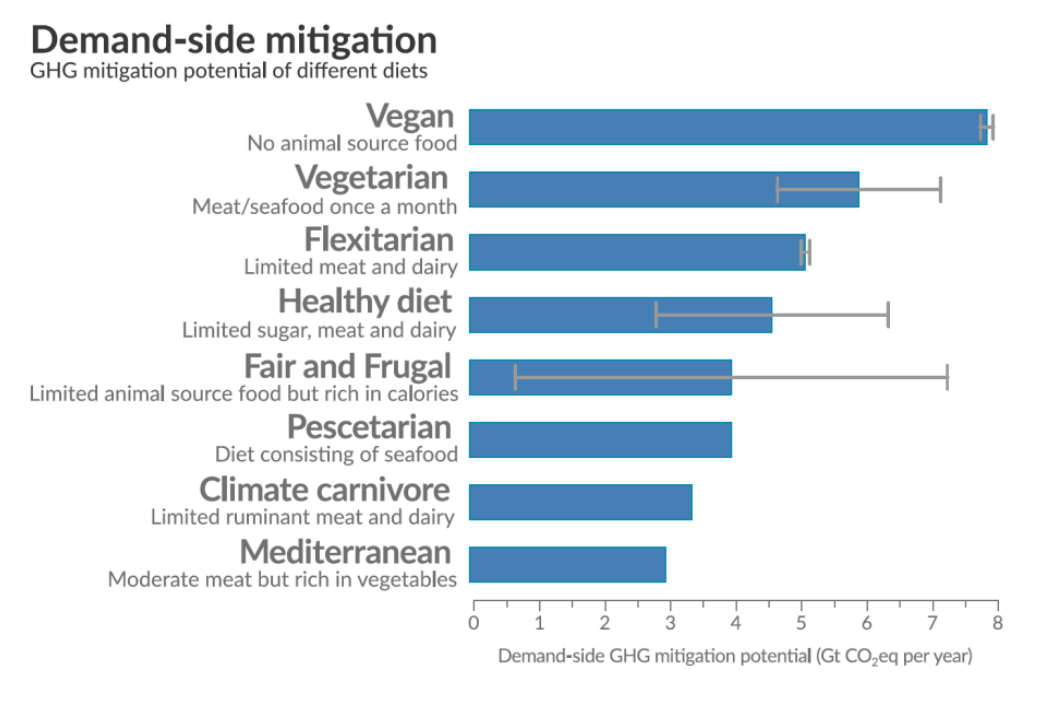
The IPCC has published a new report on climate and land. The report includes chapters on land-climate interactions (land use changes are accelerating global warming, which is causing more extreme weather), desertification (deserts are expanding), land degradation (declining quality of soil, for example), and food security. The latter is a particularly critical topic, given our dependence on food and water supplies for survival.
The report notes that humans struggle to efficiently manage our food supply. Between 25 and 30 percent of the food we produce worldwide is wasted. This waste happens for different reasons in different regions – in developed countries, consumers throw out excess food, while in developing countries much of the waste is due to a lack of refrigeration as products go bad between producers and consumers. And of course refrigeration requires energy, meaning that mitigating the latter problem will generate more greenhouse gas emissions. The report estimates that food waste costs about $1 trillion per year and accounts for about 10 percent of greenhouse gas emissions from food systems. Meanwhile, 2 billion humans are overweight or obese while nearly 1 billion are undernourished, highlighting the inefficiencies and inequities in our food distribution.
Overall, 23 percent of human greenhouse gas emissions come from agriculture, forestry, and other land use. Much of this is due to emissions of the more potent greenhouse gases methane (from cattle and rice farming, for example) and nitrous oxide (from nitrogen-fertilized agricultural soils). The figure is comparable to the transportation sector (approximately 15 percent of total human greenhouse gas emissions) and electricity and heat (approximately 30 percent). The report notes that diets heavier in meat and particularly beef adversely impact both greenhouse gas emissions and health outcomes.

Potential to reduce greenhouse gas emissions from changing diets by 2050, per the research cited in the IPCC report.
Continued global warming and the associated intensification of extreme weather are expected to decrease yields in many crops. While farmers can adapt in some ways – using more land, changing the crops they grow, and raising prices – those higher costs will be passed on to consumers. The IPCC report notes that climate change and the socioeconomic path we follow will combine to determine how much food insecurity humanity faces in the coming decades.
As food prices rise, if the number of people in poverty is also increasing, that combination could create widespread hunger crises. The IPCC report envisions various different ‘Shared Socioeconomic Pathways’ in which factors like global population, poverty, inequality, food waste, and diets vary. In a world with a large population, high inequality and poverty, inefficient food use and diets, the risk of food insecurity becomes high at 1.5°C (2.7°F) and very high at 2.5°C (4.5°F). If we follow a more sustainable socioeconomic scenario with a stable global population, low inequality and poverty, efficient food use and diets, the risk of food insecurity becomes high closer to 3°C (5.4°F). Water scarcity is a similar story, with high risks at 1.5°C if we follow a less sustainable socioeconomic pathway, and closer to 3°C if population growth and income inequality are minimized.
The importance of these factors in avoiding widespread crises among poorer populations is among the reasons why modern climate policy proposals like the Green New Deal are aimed at alleviating both inequality and climate change. Adding to the challenge, the nutritional content of many crops, including wheat and rice, will decline in a world with more heat and carbon dioxide. Higher temperatures will also make fruits and vegetables rot more quickly, thus exacerbating the problem of food waste and energy needed for refrigeration.
In short, preventing food and water scarcity in a world with more intense heat and droughts will be a challenge. Slowing global warming by curbing greenhouse gas emissions will help mitigate the problem, but the risks will also depend on the size of the population remaining in poverty. Hence climate policy solutions must address both emissions and socioeconomic inequalities.
The IPCC report lists various adaptation and mitigation measures that could be implemented, including more sustainable food production and diets (more plant-based, less meat-based), improved forest management (including reducing deforestation and increasing reforestation), agricultural carbon sequestration (including no-till farming practices), and reducing food waste. And it warns that delaying action will be costly:
“Deferral of [greenhouse gas] emissions reductions from all sectors implies trade-offs including irreversible loss in land ecosystem functions and services required for food, health, habitable settlements and production, leading to increasingly significant economic impacts on many countries in many regions of the world. Delaying action as is assumed in high emissions scenarios could result in some irreversible impacts on some ecosystems, which in the longer-term has the potential to lead to substantial additional [greenhouse gas] emissions from ecosystems that would accelerate global warming.”
Last year’s IPCC Special Report on climate impacts at 1.5°C concluded that to limit global warming to this level, global greenhouse gas emissions need to decline by about 45 percent below 2010 levels by 2030, which led to many headlines and declarations that we only have 12 years left to avert a climate catastrophe. Reality is more complicated than this simple message; for example, how one defines “catastrophe” is subjective. The IPCC land report documents that the risks associated with food and water insecurity, extreme weather, desertification, land degradation, human conflict, and other climate change threats will only grow as temperatures rise above today’s level of 1°C hotter than pre-industrial temperatures.
However, the report also illustrates that in combination with sustainable and equitable growth, we can always reduce those threats beyond what they would be at higher global temperatures. We are essentially entering an era of permanent damage control. That may not make for as sexy a headline as ’12 years to avert catastrophe,’ but it more accurately describes our state of affairs.
Posted by dana1981 on Thursday, 29 August, 2019
 |
The Skeptical Science website by Skeptical Science is licensed under a Creative Commons Attribution 3.0 Unported License. |